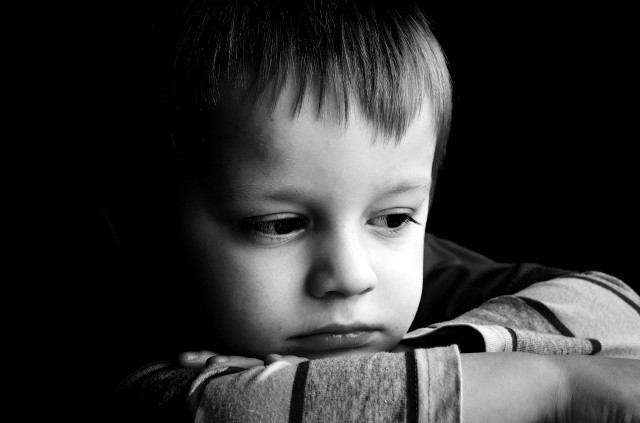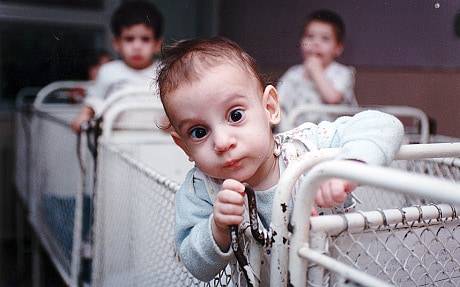Trauma and development

The effect of abuse, neglect or trauma on the development of a child is a very important but difficult topic to study. Psychologists study the effects of what are called Adverse Childhood Experiences (ACE’s) - that is, physical abuse, sexual abuse, exposure to domestic violence and a substance-abusing parent. Research indicates that the effects of abuse depend on the child’s age and gender, as well as the duration of the experience.
There are two types of effects as a result of deprivation (neglect) or trauma. First, there are the physiological and neurodevelopmental effects. Secondly, there are the effects on a child's psychosocial development.
Unfortunately, abuse and neglect are not uncommon. According to the U.S. Department of Health and Human Services, every year more over 3 million reports of child abuse are made in the United States. On average, the United States loses between four and seven children every day to child abuse and neglect.
Child abuse occurs at every socioeconomic level, across ethnic and cultural lines, within all religions and at all levels of education. Studies indicate that about 30% of abused and neglected children will later abuse their own children.
To get a better understanding of the concept of ACE's and the effect that they have on a child's development, watch the following video featuring American pediatrician, Nadine Burke Harris.
ATL: Critical thinking
Questions
1. According to Nadine Burke Harris, what are the effects of ACE's on a child's development?
2. What do you think of Nadine Burke Harris's proposal for screening children for ACE's? Justify your position.
1. According to Nadine Burke Harris, what are the effects of ACE's on a child's development?
There are several points that she makes It affects areas like the nucleus accumbens, the pleasure and reward center of the brain that is implicated in substance dependence. It inhibits the prefrontal cortex, which is necessary for impulse control and executive function, a critical area for learning. And on MRI scans, we see measurable differences in the amygdala, the brain's fear response center. So there are real neurologic reasons why folks exposed to high doses of adversity are more likely to engage in high-risk behavior.
2. What do you think of Nadine Burke Harris's proposal for screening children for ACE's? Justify your position.
Students will have their own thoughts on this. However, it is a mistake to say that it is problematic because the data is self-reported. This is something that students often say as if there is some other way we could obtain this data! As psychologists, we are reliant on self-reported data. It does have limitations, but it is likely that if a child says that they are abused or that they lost a parent, there is some legitimacy to their claim. The question of screening children, however, is controversial in the medical field because too many doctors do not acknowledge the link between mind and body.
I highly recommend that your library have a copy of Burke-Harris's book, The Deepest Well. The book is highly readable and she addresses the resistance in the medical community to her idea.
Effects of abuse on development
 Psychologists claim that children can recover from even very adverse conditions if they are removed from such situations and given proper care and attention. This is supported by a classic case study of child abuse by Koluchova (1972). She undertook a longitudinal study of a pair of Czech twin boys who had been discovered at the age of 7 in terrible living conditions.
Psychologists claim that children can recover from even very adverse conditions if they are removed from such situations and given proper care and attention. This is supported by a classic case study of child abuse by Koluchova (1972). She undertook a longitudinal study of a pair of Czech twin boys who had been discovered at the age of 7 in terrible living conditions.
The boys’ mother had died when they were born; they were raised by their father and then later, after the father remarried, their step-mother. The step-mother kept them in conditions of severe deprivation. They had been kept locked in isolation in a cellar; they had been mistreated and beaten. They did not have adequate food, so they were suffering from vitamin deficiency when they were found. They had no access to exercise or stimulation of any kind, apart from the contact they had with each other.
Apparently, nobody knew of their existence; but by the time they reached age seven, their situation came to the attention of the authorities. At that time, the boys could hardly walk, play, or speak. They were initially placed in foster care and then later adopted by two sisters.
When they were found, the twins’ prognosis seemed very poor. The boys’ IQ scores were estimated to be around 40 at the time they were found, but by the age of 14, these had risen to around 100 for one, and 90 for the other. Their school performance was generally good and they were highly motivated. By the age of fourteen they had caught up academically to other 14-year-olds, and as adults, they were able to attend university and develop good relationships with others.
It seems that, given the right sort of loving and caring environment and the opportunity to develop an attachment to a sensitive caregiver, the effects of deprivation may be reversible. However, there are some important considerations when drawing this conclusion:
- The twins were not totally isolated, so they may have formed an attachment to each other. This may account for their ability to later form healthy relationships with others.
- The twins were discovered at the age of 7 which may explain why they recovered from the effects of their abuse; similar children who were discovered much later in life did not always demonstrate such a high level of recovery.
- Because we do not have any way of knowing the academic potential of the children prior to the abuse, we cannot say for sure how well they have recovered.
- This is a case study of two individuals, so the findings may not be easily generalized - gender, culture and historical period must be considered.
ATL: Be reflective
The following video is the story of Clayton Moss. Clayton was severely abused by this father and step-mother. His story is one of incredible resilience.
Question
Reflect on your own feelings after watching this video. What questions would you want to ask a psychologist after viewing this clip?
Why do you think that Clayton was able to "get his life together" when so many people who have suffered less, are not?
Before you assign this video clip, you should watch the video yourself. You should give students the option to not watch the video as some students will find it very disturbing, even though the focus of the story is on resilience.
Reflect on your own feelings after watching this video. What questions would you want to ask a psychologist after viewing this clip?
The responses to this question will be personal. It is important, however, that students formulate good questions. The discussion as a class could be - to what extent is it potentially possible to answer the questions they pose?
Why do you think that Clayton was able to "get his life together" when so many people who have suffered less, are not?
This is a good prompt before you study theories of resilience. It is hard to know why some people are more resilient than others. Students often pose suggestions with regard to his age when he was found, the bond he had with this sister, or the support he had in his foster home.
Effects of institutionalization on development
Some of the earliest research on deprivation was carried out by René Spitz on institutionalized children. He found that children who were in institutions were showing evidence of delayed development. They were smaller in size and they were not able to carry out appropriate developmental physiological markers such as rolling over or crawling. They also did not express emotions in a way consistent with child behaviour. Spitz coined the term hospitalism for what he saw - but he did not understand why these symptoms were happening.
In addition, neglected children also have lower cognitive performance. Dennis (1973) carried out a study of children in an orphanage in Beirut, Lebanon. He found that unadopted adolescents in institutions age 16 had a mean IQ of 50, which is classified as moderately retarded. Children adopted between 2 and 6 had a mean IQ of 80; children adopted by age 2 had a mean IQ of 100 - which is average. It appears that institutionalization also has a direct impact on a child's cognitive development.
There is evidence that long-term institutionalization of children and abuse both have an effect on the child's brain development.
Chugani et al. (2001) carried out PET scans on a sample of 10 children adopted from Romanian orphanages and compared them with 17 healthy adults and 7 children. The results showed significantly decreased activity in the prefrontal cortex, the hippocampus and the amygdala. Chugani concluded that the dysfunction in these brain regions may have resulted from the stress of early deprivation and might be linked to long-term cognitive and behavioural deficits.
Carion et al (2009) performed fMRI scans and found that children suffering from PTSD after experiencing abuse or witnessing violence performed worse on verbal memory tests and showed less hippocampal activity compared to a control group. It is believed that the reason for this is linked to the human stress response. Experiences of abuse act to increase levels of the stress hormone cortisol in children. Increased cortisol levels have a negative effect on the hippocampus which is responsible for memory consolidation.
Research in psychology: Rutter et al, 2007
 In December 1989 the Romanian people overthrew their communist dictator. Romania had been cut off from the West and most people were unaware of just how bad things were. This became very much apparent when the media reported the finding of hundreds of orphanages in which children were living in horrific conditions.
In December 1989 the Romanian people overthrew their communist dictator. Romania had been cut off from the West and most people were unaware of just how bad things were. This became very much apparent when the media reported the finding of hundreds of orphanages in which children were living in horrific conditions.
The communist dictator had outlawed birth control and abortion. It was the duty of women to bear children for the state. Police controls, as well as physical check-ups every three months, made sure that women complied. But they couldn't afford the children they bore, so they turned them over to the state. Then, an economic decline in the 1980s meant that the orphanages lacked electricity, heat, and food.
When the images of the children made the news, people from around the world wanted to adopt the children. A significant number of those adoptive parents were in the UK. This resulted in one of the largest and longest studies of the effects of deprivation and trauma on child development ever done.
Rutter et al (2007) wanted to investigate the progress of orphans brought to the UK for adoption in the 1990s.
The sample consisted of 144 Romanian children adopted by UK families. All children had been adopted between birth and 42 months. For comparison, the researchers used a group of 52 domestic adoptees who had not experienced a depriving institutional experience and were less than 6 months old at the time of adoption.
Rutter studied three groups:
- Adopted before the age of 6 months
- Adopted between 6 months and 2 years
- Adopted after the age of two (late adoptees)
Both the British and Romanian adoptees were first assessed at the age of 4 years. Data was then collected again at the age of 6 and then a final assessment was carried out at age 11.
Semi-structured interviews were carried out with the adoptive parents to discuss the child's behaviour. Children were also given standardized tests to assess their cognitive abilities.
Cognitive impairment was found in 15.4% of the adoptees from Romania but in only 2.3% of the adoptees from the UK.
According to Rutter, there was a response-dose relationship between institutionalization and both cognitive impairment and attachment disorders - that means, those that spent a longer time in the institution were more likely to have more persistent cognitive deficiencies and disinhibited attachment - that is, a lack of close, confiding relationships, rather indiscriminate friendliness and clingy, attention-seeking behaviour, a relative lack of differentiation in response to adults, a tendency to go off with strangers and a lack of checking back with a parent in anxiety-provoking situations.
For those who spent between 6 and 24 months in an institution, 12% of children demonstrated cognitive impairment at age 6. For those who were in the institution for more than 24 months, 36% demonstrated significant cognitive impairment.
The researchers concluded that the negative effects of institutionalization could be overcome if intervention took place before 6 months of age.
The Rutter study supports the findings of Bowlby regarding the role of a sensitive period in which optimal cognitive development takes place - that is, under 2.5 years.
Kreppner, O’Connor, Dunn & Andersen Wood (1999) had similar findings in their study of 104 Romanian orphans adopted into British families before the age of 2 compared to 50 British adoptees. Analysis for group differences between UK adoptees and the Romanian adoptee groups indicated a general tendency for the UK adoptees to engage in higher frequencies of pretend play, role play and referencing others’ mental states than Romanian adoptees.
However, it is difficult to separate out the role of malnutrition in this study. Rutter found that there was a persistent cognitive deficit at age six in the children who were in the institutions the longest. This appeared to be the case most often in those that had suffered from malnutrition.
ATL: Thinking critically
Rutter's study has quickly become a "classic" in psychology. There are many strengths to the design and the sample of the study. For each of the points listed below, explain why it would be considered a strength of the study.
- A substantial proportion of the parents that adopted children already had children of their own.
- The degree of deprivation was unusually severe.
- Almost all children had been placed in the institution in early infancy.
- There had been no adoptions from institutions in Romania prior to 1989.
- The adopted Romanian children were ethnically similar to their adoptive parents.
This exercise asks students to "explain" strengths. In essays, we often find that students are great at discussing limitations, but they really struggle to identify strengths of a study and to discuss them in the context of the study. Remember, the findings of a study are not a strength.
1. A substantial proportion of the parents that adopted children already had children of their own.
This is important because we cannot then attribute parenting skills (or the lack thereof) to the reason for the children's resilience. The sample of parents had a wide range of parenting experience and skill.
2. The degree of deprivation was unusually severe.
This is important because trauma is based on the interpretation of an event. Two people may experience the same trauma - e.g divorce and separation from a parent, but one person may not see it as highly meaningful or important. In this case, we can assume that the trauma had an effect on the individuals in the study. It is not up for debate whether this was a traumatic experience.
3. Almost all children had been placed in the institution in early infancy.
This means that the children had only experienced the institution and had not developed an attachment to their caregiver. Children who would be placed in the institution later in life may show different types or levels of trauma.
4. There had been no adoptions from institutions in Romania prior to 1989.
This is important because it means that the older children were not children who had "failed to be adopted" which might indicate some trait that would serve as a confounding variable.
5. The adopted Romanian children were ethnically similar to their adoptive parents.
This is important because "looking like" your family is important in the development of social identity. Seeing the parents as "outsiders" might have been a barrier to providing the protective support needed for development.
Checking for understanding
Which of the following is true of case studies of victims of child abuse?
According to Nadine Burke Harris, one of the results of adverse childhood experiences could be
According to Nadine Burke Harris, what is true about "adverse childhood experiences" ?
In the Kolochova study, what might explain the recovery in both the cognitive and social development seen in the two boys?
René Spitz carried out research of children in institutions. He observed many negative behaviours which he labeled as symptoms of "hospitalism." According to Spitz, which of the following is a symptom of hospitalism?
Research by both Chugani and Carion indicates that
According to Rutter's research on Romanian orphans, the negative effects of institutionalization may be overcome if intervention takes place before what age?

 IB Docs (2) Team
IB Docs (2) Team
